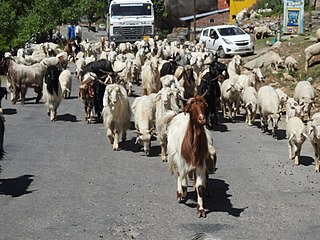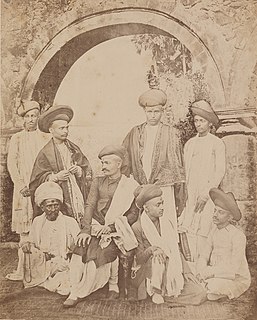Related Research Articles
Brahmin are a varna (class) in Hinduism. They specialised as intellectuals, kings, priests, teachers, ayurvedic physicians and protectors of sacred learning across generations.

The Gaddi is a semi-pastoral and Agriculture practising Indo Aryan ethno-Linguistic Group living mainly in the Indian states of Himachal Pradesh and Jammu and Kashmir.
Niyogi Brahmin is a Telugu Brahmin subcaste native to the Indian States of Andhra Pradesh and Telangana, but are spread throughout South India and Maharashtra. The traditional occupations of the Niyogi Brahmins are settled cultivation and priest hood. But majority of them took up various secular vocations including military activities and patwaris. They were associated with administration, economics, literature, music composing, politics, scholarly, scientific, engineering, defense and warfare careers.
Telugu Brahmins are Brahmin communities native to the Indian states of Andhra Pradesh and Telangana.
Saryupareen Brahmins, also known as Sarvarya Brahmins, Sarjupar Brahmins or Saryupariya Brahmins, are North Indian Brahmins residing on the eastern plain of the Sarayu near Ayodhya. Saryupareen families, were involved solely in the research and analysis of Vedas and other religious texts, performing yajnas and other religious practices. These families perform "pujas" for benefactors and take "dakshinas" (donations) for Those prayers. Hence, they were considered to be solely devoted to the quest of learning about the Vedas and spreading knowledge rather than benefiting in any way through benefactors. Along with the other Pancha-Gauda Brahmin communities, the Saryupareen traditionally preserve the customs and traditions as prescribed by ancient Hindu canons.
Dravida Brahmins is a sub-caste of the Telugu Brahmins of Andhra Pradesh in South India, who migrated from Tamil Nadu in history.

The Nagar Brahmin are a Hindu Brahmin caste of India. They are among the most ancient of all Brahmin communities. They are primarily found in Gujarat but have a history of migration to Rajasthan, Uttar Pradesh and Madhya Pradesh, in the north and central, Maharashtra and Karnataka further west and into the south, and as far as West Bengal in the east. In North India, the Bias Brahmin community includes Nagar Brahmins and two other Brahmin groups from Gujarat: the Audichya Brahmins and the Bardai Brahmins. Many modern day Nagar families are settled outside of India in the United States, Canada, the UK and Australia.
The North Indian state of Himachal Pradesh is a state that has remained largely uninfluenced by Western culture. Himachal Pradesh is a multi-religion practising, multicultural and multilingual state. Some of the most commonly spoken languages are Hindi and the various Pahari languages. The Hindu communities residing in Himachal include the Brahmins, Rajputs, Kannets, Rathis and Kolis. There are also tribal population in the state which mainly comprise Gaddis, Kinnarms, Gujjars, Pangawals and Lahaulis.
Tyagi originally called Taga, is a cultivator caste who claim Brahmin status. The landholding community is confined to Western Uttar Pradesh, Haryana, Delhi and Rajasthan. They are often considered the highest of the agricultural castes. During the British Raj, they changed their name from Taga to Tyagi, and began claiming Brahmin status. In 1931, they were classified as a cultivating middle caste rather than as Brahmins, along with the Jats and Bhumihars. As of a 1990 report by the Backward Classes Commission, Government of Haryana, they were mostly engaged in farming.

Kushabhau Thakre was an Indian politician belonging to Bharatiya Janata Party and Member of parliament.
Kanyakubja Brahmins, are a Brahmin community mainly found in northern India. They are classified as one of the Pancha Gauda Brahmin communities native to the north of the Vindhyas.
The name can also be spelled as Sanadya Brahmin or Sanadh Brahmin, or Sanah Brahmin or Sanidya Brahmin or Gour Sanadhya are a community of Brahmins. Their main concentration is in western Uttar Pradesh, Rajasthan, Delhi and Madhya Pradesh area of India. The Hindi poet Keshabdasa Mishra was a Sanadhya, and praised his community in his Ramachandrika.
Gauda, or Gaur/Gaud is a group of Brahmin communities in India. The Gauda Brahmins are one of the five Pancha Gauda Brahmin communities that originally lived to the north of the Vindhyas. Gauda Brahmins are most numerous in the western half of northern India, particularly in the western parts of the states of Uttar Pradesh and Madhya Pradesh, in the state of Haryana and in the state of Rajasthan.
The demographics of Uttar Pradesh is a complex topic, which is undergoing dynamic change. Uttar Pradesh is India's most populous state, and the largest subdivision in the world. It has a population of about 199,812,341 as per the 2011 census. If it were a separate country, Uttar Pradesh would be the world's fifth most populous nation, next only to China, India, the United States of America and Indonesia. Uttar Pradesh has a population more than that of Pakistan. There is an average population density of 828 persons per km² i.e. 2,146 per sq mi. The capital of Uttar Pradesh is Lucknow, and Allahabad serves as the state’s judicial capital. Hindus and Muslims both consider the state as a holy place.
The Muslim Kayastha, a community of Muslims, are related to education-oriented Kayastha of northern India, mainly in modern Uttar Pradesh who converted to Islam during the rule of Muslim dynasties. The Muslim Kayastha and Nagar Muslims of Uttar Pradesh are considered Shaikh and follow Sunni Hanafi fiqh. The Muslim Kayasths have intermarried with the other Muslim communities over the centuries and have lost their community consciousness and consider themselves to be part of the Urdu speaking Muslims of Pakistan and northern India. They primarily belong to the state of Uttar Pradesh in India. An important point to be noted is that the word Muslim Kayastha has no Islamic scripture's backing.
The Muslim Raibhat are a Muslim community found in North India. They are converts to Islam from the Rai Bhatt community. The Muslim Rai Bhatt are the heredity bards and genealogists of many communities in India. A small number are also found in the city of Karachi in Pakistan, where they now form a component of the Muhajir community. Muslim Rai Bhatt Bhat is not only in Uttar Pradesh but is registered in the Indian Gazette all over India but according to the state, all are placed in different categories.
[Gujarat best work] and mony market] [fish farming ]What The Nagar Muslims are a Muslim community found in the state of Uttar Pradesh in India. They are Muslim converts from the larger Nagar Brahmin community. The Nagar are also known as Nagar Shaikh.

Aihar is a village in Dalmau block of Raebareli district, Uttar Pradesh, India. Located east of Dalmau on the road from Lalganj to Raebareli, Aihar hosts a Baleshwar mela on Phalguna Badi 13 that is associated with the Shivratra festival and is dedicated to the worship of Shiva. It also hosts a market twice per week, on Tuesdays and Saturdays, specialising in cattle, cloth, and vegetables. As of 2011, the population of Aihar is 7,502, in 1,337 households, and it has 4 primary schools and 1 small clinic.

Mahendra Nath Pandey is an Indian politician currently serving as Minister of Heavy Industries he previously served as Minister for Skill Development and Entrepreneurship of India and Member of Lok Sabha for Chandauli since 2014. He is a member of Bharatiya Janata Party and is the president of the party's Uttar Pradesh unit. He has also served as Union Minister of State for Ministry of Human Resource Development between 2016 and 2017. He is a member of Modi's second ministry. On 30 May 2019, he was appointed as Cabinet minister for Skill Development and Entrepreneurship, Government of India.
References
- ↑ Jati Bhaskar by Pt. Jwala Prasad Mishra